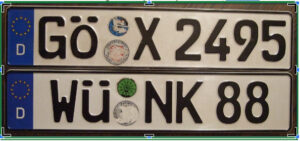Secure order and payment
09. 08. 2022
A Complete Guide On Car Registration Plates In Europe
After purchase, all vehicles need to be registered with the appropriate transport authority in the country where they will be driven. Registration ensures that vehicles and their drivers are regulated and monitored accordingly.
Car registration plates are assigned to vehicles after registration in the EU. Car registration plates contain a specific number which belongs to the car in question, making each vehicle unique, and they are attached to the front and back of the vehicle.
EU members have adopted some general customs regarding car registration, making transport easier to regulate within the EU. When buying a car online in the EU, you should be familiar with car registration plates in EU countries and their surrounding rules.
Reading forward, you will come across all the vital information that concerns European car registration plates including the rules and the differences between countries.
Format of EU Car Registration Plates
The most important aspect of car registration plates is the number that they bear, as this differentiates them from other cars in the same country. However, the exact appearance of a vehicle registration plate is also very important.
In the EU, there are standards that govern what a car registration plate looks like, including its size and overall design. Here are the most vital aspects to take note of.
Size:
For uniformity, a vehicle registration plate cannot simply be made in any size. So, there are approved dimensions for the length and width of license plates.
There are two license plate sizes that are most commonly used in Europe, and they are:
- 520 mm x 110 mm (20.5 inches x 4.3 inches)
- 520 mm x 120 mm (20.5 inches x 4.7 inches)
The dimensions mentioned above are not limited to Europe but are also quite popular in the rest of the world. Some EU countries do not stick to the sizes above for their license plates. A few of them are:
- Finland: 440 mm x 120 mm (17.3 inches x 4.7 inches)
- Italy: 360 mm x 110 mm (14.2 inches x 4.3 inches) (for their front plates only)
Some other countries in Europe that do not belong to the EU also often step away from the common format, including;
- San Marino: 390 mm x 120 mm (15.4 inches x 4.7 inches)
- Andora: 330 mm x 140 mm (13 inches x 5.5 inches)
- Switzerland and Liechtenstein: 300 mm x 80 mm (11.8 inches x 3.1 inches) (for their front plates only)
- Monaco: 260 mm x 110 mm (10.2 inches x 4.3 inches)
Apart from all the sizes for number plates listed above, there are still a few more size standards that some European countries use, such as;
- 305 mm x 152 mm (12 inches x 6 inches)
- 305 mm x 160 mm (12 inches x 6.3 inches)
- 372 mm x 135 mm (14.6 inches x 5.3 inches)
If you intend to drive a car in Europe, its number plate will most likely fall under any of the categories listed above.
Appearance
Another characteristic of car registration plates in Europe that is regulated is their appearance, especially for countries that belong to the EU.
Since the European Union is connected in a lot of ways including transportation, the member countries have license plates that share some features. This way, EU vehicles are easy to identify, making journeys across the EU a lot more convenient.
The most notable physical feature shared by license plates in EU countries is the left section which is blue and contains a circle of 12 yellow stars. This design is a replica of the EU flag and is used to show uniformity among EU member nations.
The EU flag on car registration plates is complemented by the international vehicle registration code of that country.
International vehicle registration codes serve to distinguish countries from each other, making vehicles easy to identify. When a car is being driven in a country different from where it was registered, the vehicle registration code of its original country must be displayed on its rear.
Below are some examples of EU member countries and their corresponding international vehicle registration code:
- France – F
- Belgium – B
- Spain – E
- Germany – D
- The Netherlands – NL
- Denmark – DK
Apart from the blue EU flag on the left of the plate, EU vehicle registration plates are either white or yellow in colour. They are also often made from metal, even though Ireland, France, and Sweden often use both metal and plastic plates.
Examples Of Vehicle Registration Plates In EU Countries
As mentioned earlier, vehicle registration plates in EU countries share some features, but also have some differences.
To help you further understand number plate registration in Europe, we will be exploring the characteristics of car registration plates in some EU countries, namely; Germany, France, Spain, and the Netherlands.
Germany Vehicle Registration Plates
In Germany, the colour of a vehicle registration plate is white, and the characters that make up the registration digits are black.
The common size for car registration plates is 520 mm x 110 mm (20.5 inches x 4.3 inches), which is one of the most popular license dimensions in Europe.
Like the rest of the EU, German license plates are designed with the customary EU flag on the left – a blue section with a circle of 12 yellow stars. Towards the bottom of the EU flag on the plate is Germany’s international vehicle registration code, which is the letter ‘D’.
The first group of characters on a German license plate serve as the area code of the region where the car was registered, and are either one, two, or three letters. For a complete list of German license area codes, check here.
The area code is followed by a Registration sticker of the corresponding German state at the bottom and a Safety Test sticker with an expiry date at the top. Both stickers appear on the back plate, while front plates routinely have the Registration sticker alone.
The final section of characters is a group of letters and numbers, reaching up to six characters in total. This group of characters serves as a serial number to differentiate vehicles.
France Vehicle Registration Plates
Like their German counterparts, French vehicle registration plates are also white in colour, and the characters that denote their registration number are black.
Car registration plates in France also have the EU flag on their left side, and their international vehicle registration code, which is the letter ‘F’.
The standard size of French registration plates is 520 mm x 110 mm (20.5 inches x 4.3 inches).
The registration characters consist of three groups of characters – two letters, three numbers, and two letters – and they are each separated by a dash.
The final component of license plates in France is a blue strip at the right end of the plate. This blue section contains the logo of a French region and its corresponding code.
French car owners can decide whichever region they want on their car, regardless of the region where the vehicle gets registered.
Spain Vehicle Registration Plates
A Spanish vehicle registration plate is also white and contains black-coloured characters except for special cases like non-private vehicles that get colour plates.
Spanish vehicle registration plates also have the EU flag on their left and are tagged with their international vehicle registration code, the letter ‘E’.
There are seven characters in sequence on Spanish license plates, the first four being numbers, and the last three being letters.
The Netherlands Vehicle Registration Plates
Unlike the three countries discussed above, car registration plates in the Netherlands are coloured yellow, even though their registration characters are also black.
Together with the EU flag on the left, license plates in the Netherlands are stamped with their international vehicle registration code, the letters ‘NL’.
The characters on the license plates for cars in the Netherlands are a combination of letters and numbers and their format is determined by the year of registration. You can view the full list here.
General Requirement For Vehicle Registration In The EU
From the four countries cited above, it is obvious that there are a lot of differences within the EU regarding vehicle registration. However, one requirement that is constant among all EU countries is a Certificate of Conformity (COC).
A European Certificate of Conformity declares that a vehicle is compliant with EU transport regulations. If you buy a car abroad and want to register it, most EU countries require a Certificate of Conformity.
EUROCOC helps people get Certificates of Conformity online with maximum convenience. Our services are without delay, and we deliver COCs at very affordable prices. To complete your car registration, order a European COC now.
Registration Authorities In Different EU Countries
Here is a list of some notable EU countries and their transport registration authority:
| COUNTRY | REGISTRATION AUTHORITY |
| Spain | Dirección General de Tráfico |
| The Netherlands | RDW |
| Belgium | Federale Overheidsdienst Mobiliteit en Vervoer |
| Germany | TUV |
| Portugal | Instituto do Registos et Notariado |
For a more extensive list containing most European transport authorities, check here.












